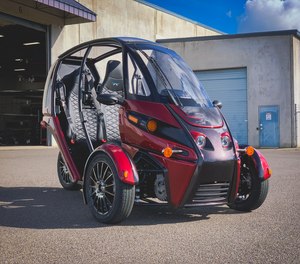
While world leaders debate and approve actions to reduce methane emissions and protect forests, public safety is already putting no-emission electric vehicles into service
While leaders from 90 countries are meeting in Glasgow, Scotland, this week for the UN Climate Change Conference of the Parties (COP26) to discuss climate change and strategies to slow global temperature rise, public safety organizations are already taking action. Almost every week, we receive news from public safety organizations leading the way with electric vehicle purchases, new green building construction or renovations, or efforts to better prepare police, fire and EMS for prevention of response to illness, injury or property damage caused by natural disasters.
Here are some recent news items from law enforcement agencies, fire departments, and EMS agencies that showcase the leading role of public safety inside local and state government to accelerate action on reducing emissions and use of fossil fuels through the addition of electric vehicles to public safety fleets.
Ambulances have unique regulatory requirements to transport a two-person crew, a large amount of patient care equipment, and transport at least one patient secured to a cot that are not easily met by converting existing electric passenger vehicles or fleet vehicles. To meet the need for an all-electric ambulance several manufacturers have announced plans to develop and build an EMS-specific electric vehicle platform.
Lightning eMotors and REV Group, Inc. have partnered to develop an all-electric ambulance, based on Lightning eMotors' fourth-generation Lightning Electric Transit Van by the end of 2021. The vans offer up to 105 kWh of battery capacity and can be charged via Level 2 AC charging or DC fast charging, according to the companies.
Demers Ambulances and the Lion Electric Company , a leading manufacturer of all-electric medium and heavy-duty urban vehicles, unveiled the Demers eFX Ambulance, the first all-electric and purpose-built ambulance, in October 2021. The new ambulance is scheduled to be ready in the second half of 2022.
In the United Kingdom, the North East Ambulance Service and other services are working with Ford to design an electric double-crewed ambulance from the EV Ford Transit . The service plans to have a fully electric fleet by 2030.
Not every EMS response requires a patient transport vehicle. In 2020 the Eugene Springfield (Oregon) Fire Department began working with electric vehicle company Arcimoto to test the three-wheeled Rapid Responder . The vehicle, which can travel at a top speed of 75 miles per hour, features a miniature lightbar and siren, 360-degree scene lights, a cargo compartment, equipment rack and seating for two crewmembers. The vehicle might be useful for special event standby or areas not easily accessible to a full-size ambulance.
Community paramedics in Sudbury, Ontario, are responding to non-urgent, scheduled patient appointments from a Tesla Model 3 . City of Greater Sudbury’s Paramedic Services has four Teslas that are used during the daytime and charged at the station overnight .
Depending on how a public safety agency plans to charge their electric vehicles they will need to install either level 3 direct current chargers or level 2 alternating current chargers. Level 3 chargers, like the Tesla Supercharger network, quickly replenish a vehicle's battery but are much more expensive to install. Level 2 chargers, which most consumer electric vehicle owners use at home, are lower cost and less expensive to install, but take longer to charge the vehicle.
Leon County (Florida) Sheriff’s Office recently deployed the EV ARC solar-powered EV charging system from Beam Global to charge the department’s electric vehicles. The system generates and stores its own electricity and can be used day or night and during power outages.
Though electric vehicles are currently a fraction of a percent of total vehicle purchases by fire departments, law enforcement agencies and EMS organizations, I expect that to change rapidly in the next few years. A combination of successful implementations, lower cost, higher performance, accelerating technology, increased vehicle options and lofty carbon emissions reduction goals will drive more and more electric vehicle purchases in the years ahead.
Copyright © 2025 EmsGrantsHelp.com. All rights reserved.
